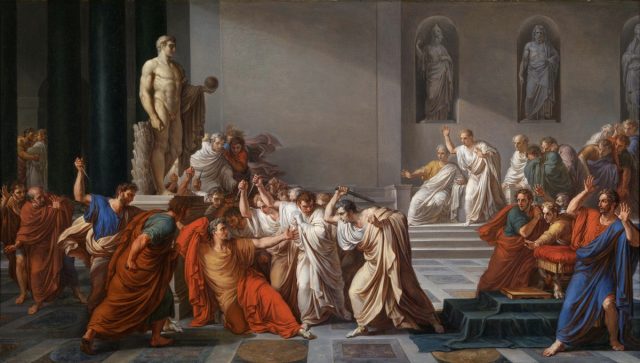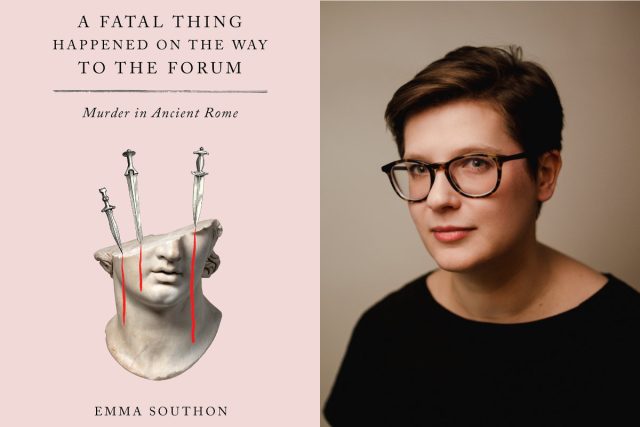Et tu, Brute? —
Emma Southon discusses her new book, A Fatal Thing Happened on the Way to the Forum.
Jennifer Ouellette
–

Enlarge / University of Birmingham historian Dr. Emma Southon explores murder in ancient Rome in her new book, A Fatal Thing Happened on the Way to the Forum.
Abrams Press
There once was a wealthy Roman man named Vedius Pollio, infamous for maintaining a reservoir of man-eating eels, into which he would throw any slaves who displeased him, resulting in their gruesome deaths. When Emperor Augustus dined with him on one memorable occasion, a servant broke a crystal goblet, and an enraged Vedius ordered the servant thrown to the eels. Augustus was shocked and ordered all the crystal at the table to be broken. Vedius was forced to pardon the servant, since he could hardly punish him for breaking one goblet when Augustus had broken so many more.
That servant seems to have been spared, but many others had their “bowels torn asunder” by the eels. And that’s just one of the many horrific ways the ancient Romans devised to kill those who displeased or offended them, from crucifixions and feeding people to wild beasts, to setting slaves on fire, and assassinating Julius Caesar on the Ides of March. Historian Emma Southon covers them all in her wittily irreverent new book, A Fatal Thing Happened on the Way to the Forum: Murder in Ancient Rome, showing us how the people of ancient Rome viewed life, death, and what it means to be human.
Inspiration struck in April 2018, when the notorious Golden State Killer, Joseph James DeAngelo, was arrested—a big day for true-crime aficionados like Southon. While chatting with a fellow true-crime buff and history teacher, Southon learned that her friend often used true crime as a teaching tool for specific cultural biases—for instance, using the example of Jeffrey Dahmer as a context for discussing homophobia in the 1990s. Intrigued, Southon searched for a true-crime book about killings in ancient Rome only to realize that nobody had written such a book. So she set out to rectify that grievous oversight, and the result is a delightful blend of true crime and ancient history.
Southon was struck by the elaborate nature of the public executions in particular. “Just having someone being eaten by a leopard wasn’t fun enough [for the Romans],” she told Ars. “They had to find ways to build narrative tension: when is it going to happen? Where is the lion going to come from?” Crucifixions occurred in the most public spaces, and the Romans presumably were inured to the sight of rotting bodies falling apart on a cross as they went about their daily activities. “Just like true crime, it’s the horror that makes it fascinating,” Southon said. “You just want to poke at the dark soul behind it and see what makes that tick.”
Ars sat down with Southon to learn more.
Ars Technica: You spend a lot of time at first talking about the definition of murder. How did you determine what constituted murder in ancient Rome for inclusion in your book?
Emma Southon: Murder is very culturally specific. It’s not that easily defined. Homicide is easily defined and has a clear definition: when one person kills another person. Murder is a word for something that is a crime, and that is different from homicide. English law is very specific. American law, because it’s so many different states, it’s wild. There’s so many different ways in which murder is defined: you have first-degree murder and second-degree murder, and then manslaughter, and then first-degree manslaughter and second-degree manslaughter. It’s so broad, and yet so specific at the same time, but if you move 10 miles in any direction, it’s a completely different thing. So I could just say, “I’m just counting all homicide as coming under the umbrella of the book,” even though the Romans would never consider any of this murder. It’s an emotive topic, and law is often much more emotive than people think it is.
Ars Technica: Did the Romans even have a legal concept of murder?
Emma Southon: They did, but it was very specific about the methods used: poisoning, or carrying a knife. But if you threw somebody off a cliff, that doesn’t fall under that law. Much later on you get things like Constantine’s law, the first one that outlaws killing enslaved people. He lists, for about a page, all of the ways in which you’re no longer allowed to deliberately kill an enslaved person. “Don’t set them on fire. Don’t throw them off of something. Don’t hit them with a rock. “Why do you need to be this specific? It’s because Roman laws are so often not aiming at generic things. They are responding to something specific. Especially when you get to the Imperial period, they are generally propagated in order to respond to a specific problem, rather than trying to make a law that is applicable to lots of things.
But they’re pretty clear it has to be intentional. Like, “You said I couldn’t set him on fire, but you didn’t say I couldn’t strangle him.” Or, “You didn’t say I couldn’t crucify him in my back garden,” or, “You didn’t say I couldn’t feed him to a lamprey.”
Ars Technica: You have a PhD in ancient history, and you’re a serious scholar, but one of the most delightful things about your book is how you imbue these tales with humor—a rare thing for history books.
Emma Southon: I don’t read that many popular history books, because I find them quite boring. I will usually skim them to see what the interesting bits are, rather than sit down and read them. I just write books that I want to read. I write what I would say to you if I were in the pub with you. If I were going to tell you the story of the lampreys, then that’s pretty much how I would describe it. What I want is for people to pick up the book and keep reading it, and say, “Wow, the Romans are pretty interesting and there’s a lot more to them than just three emperors and some white togas.”

Enlarge / La Mort de César by Vincenzo Camuccini, circa 1804.
Ars Technica: They rarely teach you the good stuff in history classes.
Emma Southon: It’s true. Everything’s hampered by curricula, is the problem. Curricula are never, like, “You know what you should do? You should show them a tintinnabulum [a decorative bell mounted on a pole] and then get people to talk about the tintinnabulum and about why somebody might put a penis-headed lion with a penis for a tail [on it].”
This is why I ended up doing ancient history. I did modern history at school, until I was 16. It’s all battles and treaties and Hitler, and then some more treaties and battles. It just was so tedious. Ancient history sounded more fun. I got a copy of Suetonius and read it and thought, “These guys are great.” It’s all just gossip and people having rude pictures and ghosts and omens. And then I read Aristophanes, a Greek comedy playwright; it’s just dick jokes all the way down. I thought, “Clearly, this was where I was always meant to be.”
The history of ancient Rome is not this boring world of Cicero shouting or Julius Caesar marching around. It is this world where they would get really upset if they stubbed their toe while they were going to an important meeting, so they’d have to go home and end the whole day because that meant the gods didn’t want them to do it. Or where they were nude all the time in the bars and had all seen each other’s penises. They’re such a weird and contradictory set of people. I love them more every year.
Ars Technica: It’s so difficult to tease out what really happened so long ago because of the scarcity of information, and the fact that the historical sources that have survived sometimes contradict one another. How do you approach this problem?
Emma Southon: The sources are always kind of dicey for the Romans. It’s so rare that you get to know what actually happened, because if you’ve got two versions of a source, then you’ve got two different versions of a story, even if they’re written by two people sitting next to one another. Romans didn’t write history like we want to write history. They didn’t write what really happened. They wrote history as literature, and what they were writing was closer to Robert Graves than it was to what we would consider to be academic history.
Once you acknowledge that, then you can see what story they’re trying to tell. What are they responding to? What’s the context in which this was written? What are they trying to do? Who is their reader? Who is their audience?” That’s how you have to approach a Roman source. If you’ve got some set of events that appear in each one, then you can be fairly sure that they’re all working from the same song book, but they are all writing their own narrative about it. Acknowledge that, and you can let go of the idea of trying to find out what really happened, and you can also accept common myths as the stories that people wanted to tell about the Romans.
People want Julius Caesar to be this great general who was an amazing person. They want that version of Julius Caesar because it tells the story of Romans who are the foundation of “the West,” which American civilization and British civilization have built themselves to emulate. Caesar had an oratorial ability and a charm about him. He could show up and people would swoon, and people chased him down the street because they loved him so much. But he was also a deranged, corrupt, upstart who didn’t care about anyone or anything except himself, who committed genocide in Gaul, killed a million people in the cruelest of circumstances and then boasted about it, and who then came back, didn’t give up his position and instead marched on Rome. He just kept granting himself honors. Nobody could reason with him or talk to him.
“History doesn’t repeat itself, but it rhymes.”
Ars Technica: We like to say history repeats itself.
Emma Southon: History doesn’t repeat itself, but it rhymes.
Ars Technica: That’s a good way to put it. What can we learn from Roman murder that is applicable to us today?
Emma Southon: If you’re on Twitter, you get people coming at you all the time with Cicero in their bio who want to tell you about Western civilization and how great it was. They love the version of Rome that we are so often shown in popular media and that is embedded so strongly even in our architecture. Looking at the world through Roman murder, and how they treated people they thought were important or not important, you see that this is either what [the Cicero fans on Twitter] want, or they don’t realize what they are advocating for: a world entirely propped up by slavery, in which it is very explicit that some people count and some people don’t count. The thing that makes you count is your family background and your wealth, and that’s about it.

Enlarge / Historian Emma Southon infuses her history of murder in ancient Rome with humor and loads of colorful details.
Abrams Press/Emma Southon
You either have to expose this stuff and force people who say they want [this type of] western civilization and be explicit about it, or you have to make them confront that, and hopefully they’ll back down. One of the things I wanted to do is to show that it was pretty grim, guys. It makes you feel a bit better about now. We’ve never had anybody, to my knowledge, raped to death by a bull [or a giraffe, in the legend of Locusta] in public for fun.
Ars Technica: You include an epigram right at the beginning of the book about how right and wrong are geometrical. What about that resonates with you?
Emma Southon: That is from Donald Black’s Pure Sociology and it really stuck with me. There’s another book that I was reading, called Is Killing Wrong? which is a very fun book to read in public. It outlines the thing that the Romans made reality, that in the modern world is less explicit: the notion that rightness and wrongness have levels. If all you had left were our laws, you would be able to write, as a historian 2,000 years from now, “Murder was illegal, and anyone who committed murder against anyone was arrested, and these were the penalties that were handed out for them,” because most of them are pretty clear.
You would think that that was presumably universal, but when you look at the reality of the situation, you’ll find that if a black man kills a white woman, that’s more wrong than if a white man kills a black man, because the black man will likely get a death sentence and the white man won’t. A homeless person killing a CEO is going to get a much harsher penalty than a CEO killing a homeless person. There are levels to what our system actually considers to be right and wrong. I found that really useful as a lens as I was combing through [archives], looking for all the [Roman] murders I could find. That’s the geometric nature of the way that we see right and wrong in terms of murder.

